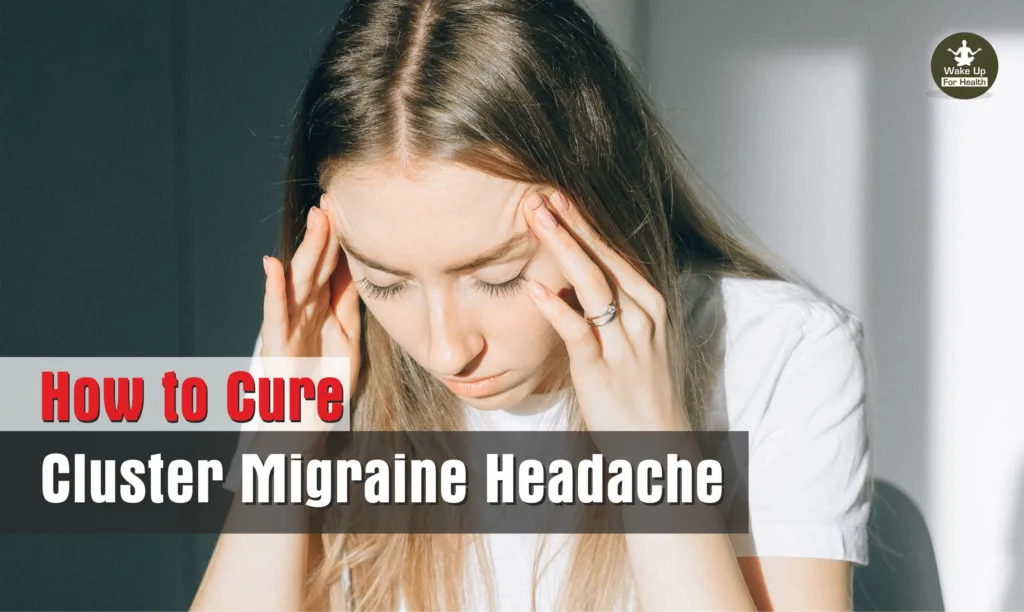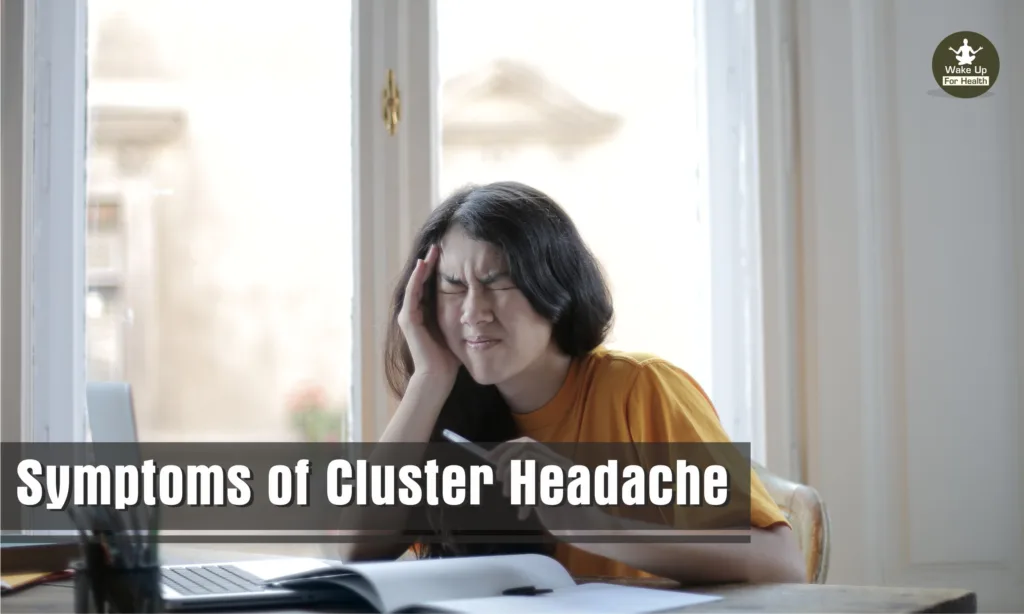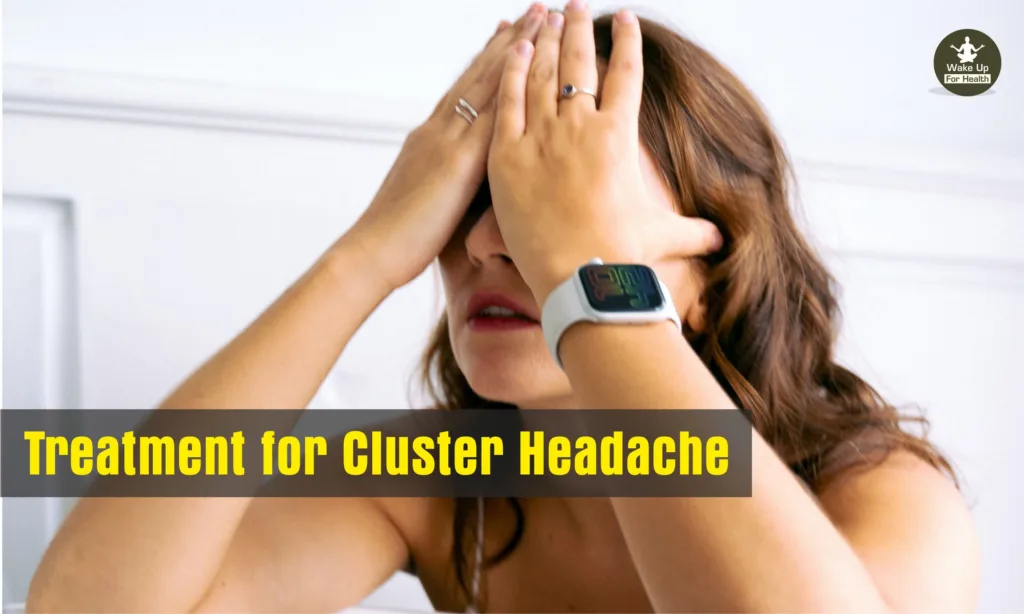One side of the head and the region surrounding the eye are both affected by the uncommon type of headache known as a cluster headache. Cluster headache attacks are frequent and repeated. It usually occurs daily for 15 minutes to three hours or regularly for weeks and months. Hence it is called a cluster period. Cluster headaches tend to occur around the same time each year, such as in the spring or fall. The cluster arises out of nowhere, persists for approximately an hour, and then abruptly vanishes. Below we’ll know more about what is cluster migraine headache, its types, symptoms, treatment for cluster headache, causes and home remedies for cluster headache.

Compared to migraine, sinus headache, and tension headache, cluster headache is the most severe. If the problem increases further then it can become a serious situation for you. Because of this, prompt treatment is required. It also has some symptoms, if you pay attention to it then you can understand its initial condition.
What are the Types of Cluster Headache?, Dealing with Cluster Migraines
Cluster headache is divided into two parts on the basis of its severity and stage. These are something like this.
1. Chronic
This type of cluster headache affects about 15 to 20 percent of people. In this, patients experience headache lasting for more than a year. This headache can also be continuous without getting cured and some people’s headache starts getting cured after a month.
2. Episodic
This cluster headache can affect 85 to 90 percent of people. In this, patients experience daily attacks for weeks to months. Then there is rest for a few months or years. These headaches usually occur once or twice a year and can last for months.
Hyperactivity Disorder in children, what is ADHD?
What are the symptoms of Cluster Headache?, Identifying Types, Home Remedies

Cluster headaches affect multiple body systems. A person with cluster headache often has rapid attacks without any symptoms and is initially accompanied by migraine-like nausea and vomiting. Gradually, these symptoms of cluster headache start appearing:
• Pain in the head, neck, or eye or part of the face
• Restlessness
• Shedding more tears
• Red eyes
• Running nose
• Sweating on the face and forehead
• Yellowing of the skin
• Swelling around the eyes
• Difficulty blinking
Sometimes some people do not have any of these symptoms and suddenly the person starts having severe restlessness and nervousness.
Other symptoms include the following as well:
• Shrinkage of the eyeball
• Being sensitive to light
• Swelling in both eyes
• Red and hot face
• Eye irritation
Cluster headaches usually start around the eyes and then spread to other parts of the head, including the neck, face, shoulders. A person with a cluster headache might wake up every night at the same time. Each cluster lasts from 15 minutes to a few hours but usually no more than an hour. Every day, there could be one to three clusters.
TMJ Treatment, Procedure and Side Effect – Must Read.
What are the Causes of Cluster Headache?
The cause of cluster headache is not completely clear. Some of the reasons cited as hypotheses in studies are as follows:
It is believed that this headache may be caused by a sudden release of the chemical histamine or serotonin in the body’s trigeminal nerve, a nerve area related to the face. Histamine is a chemical made during an allergic reaction in the body, and serotonin is a chemical made by nerve cells. This problem can also be caused by the hypothalamus, which is a small part of the brain.
Additionally, heredity might contribute to cluster headaches.
• Consumption of alcohol and cigarettes
• Trekking and air travel
• Sun and any other bright light
• More physical activity
• Warmth
• Foods high in nitrates such as meat
• some medicines
• Cocaine use
What is the reason for the Cluster Headache?
It is unclear what specifically causes cluster headaches. But several processes in the hypothalamus are the root of this issue. The hypothalamus is the part of the brain that regulates body temperature, hunger, and thirst. Apart from this, chemicals are secreted in this part of the brain which dilate the blood vessels and increase the flow of blood to the brain.
Cluster headache attacks are triggered by excessive alcohol consumption, a sudden rise in body temperature, and exercise in a hot environment. The cyclic nature of cluster heads is linked to the biological clock in the hypothalamus. During cluster headaches, melatonin and cortisol levels in the brain become abnormal. Additionally, the body’s unexpected release of histamine and serotonin from the trigeminal nerve in the face causes cluster headaches.
What are the Risk Factors of Cluster Headache?
Cluster headache is not a life threatening disease. Typically, it doesn’t result in the brain changing permanently. But if the headache is ignored for a long period, it might worsen and harm the blood vessels. In addition to this, the hypothalamus may also be affected. A cluster headache sufferer may have effects on both their daily activities and functionality. Contact your doctor for more details.
Alzheimers Disease Attacking Such Bodies and Nature of Life.
What is the Treatment For Cluster Headache?
To diagnose cluster headache, the doctor examines the body and also looks at the family history of the patient. To diagnose this condition, certain tests are carried out:
• MRI
Using a magnetic field and radio waves to image the brain and blood vessels and detect abnormalities.
• CT Scan
A cross sectional image of the brain is taken using X-rays and the levels of chemicals are checked.
Cluster headaches have a specific type of pain and attacks in some patients. In this case, the doctor diagnoses the disease on the basis of the affected part of the patient’s head or eye, severity and associated symptoms. During a cluster attack, doctors diagnose Horner’s syndrome, which is the problem of heaviness on the eyelids and the problem of constriction of the pupil, by physical examination.

What is the Treatment for Cluster Headache?
There is no exact cure for cluster headache. However, some treatments and medications reduce the effects of cluster headache in a person. There are several types of medications for cluster headache:
• Sumatriptan injection is given to cure cluster headache. Simultaneously, sumatriptan is sprayed into the nose. Triptan drugs such as zolmitriptan are given to reduce cluster headaches.
• The drug octreotide is injected. It is a synthetic version of the brain hormone somatostatin which quickly reduces the pain of cluster headaches.
• Injection of dihydroergotamine is given to reduce the pain of cluster headache.
• Calcium channel blocking agent helps prevent cluster headache. Verpa Mil may also be used in combination with other medicines.
• Prednisone and other corticosteroids are particularly good in lessening cluster headaches.
• Lithium carbonate helps in curing severe cluster headache.
• Breathing with 100% pure oxygen at the onset of cluster headache reduces the symptoms of this disease.
If the symptoms of cluster headache do not subside with medication, the disease is treated with surgery. After the surgery, the person gets rid of cluster headache permanently. Doctors perform surgery by injecting a neurotransmitter along with sphenopalatine ganglion stimulation to relieve headache symptoms.
Do Not Make These 9 Mistakes During Meditation.
What are the Home Remedies for Cluster Headache?
Cluster headaches are 5 to 6 times more common in men than in women. According to experts, apart from medicines, you can adopt home remedies to overcome cluster headache.
1. Apply Sandalwood Paste
Using sandalwood paste to help soothe cluster headaches is a centuries-old home remedy. It helps in reducing headache by calming the tense nerve in the optic region. For this, make a paste using some water and half a teaspoon of sandalwood powder. Apply a thin layer of this paste on your forehead. Leave it on for 20 minutes before washing it off with cold water.
2. Drink Herbal Tea
To get rid of cluster headaches, have a cup of chamomile tea every day. It has anti inflammatory, anti spasmodic properties. To make this, soak two to three teaspoons of dried chamomile flowers in one cup of hot water for a few minutes. Add some lemon juice and honey. Now filter this water and drink it three to four times a day.
3. Quit Smoking
If you smoke, this may target your cluster headaches. Apart from this, exposure to second hand smoke is also harmful and can have many side effects. According to a study, people suffering from cluster headache should quit smoking completely. By doing this the headache can be reduced.
4. Do Yoga Everyday
Yoga is an alternative treatment that has been practiced for centuries to cure chronic pain. According to a study published in PubMed Central, yoga, a combination of various postures and deep breathing exercises, promotes a person’s overall health. A 2015 study published in the Journal of Physical Therapy Science confirms that yoga should be used as a therapy. Setubandhasana, Padma Asana, Shavasana, Hastapadasana and Downward Breathing can be practised for a short period of time each day.
5. Include Magnesium in the Diet
Magnesium is an essential nutrient that helps regulate various metabolic processes and the central nervous system. A daily intake of 300-400 mg of magnesium is sufficient. According to a 2015 study published in Nutrients, a drop in magnesium levels can lead to a number of diseases. Therefore, include magnesium-rich foods like sesame seeds, sunflower seeds, almonds, oatmeal, eggs, peanut butter in your diet.
Cluster headache is incurable, yet you can try the home remedies mentioned above to reduce the discomfort. Doctors recommend that apart from medicines, it is very important to adopt healthy habits, massage and change your diet to reduce the severity of cluster headaches.
(Disclaimer : The purpose of this health-related article is to wake you up and aware of your health and to provide health-related information. Your doctor has a better understanding of your health and there is no substitute for their advice.)
5 thoughts on “Cluster Migraine Headache | Types, Symptoms, Treatment & Home Remedies”